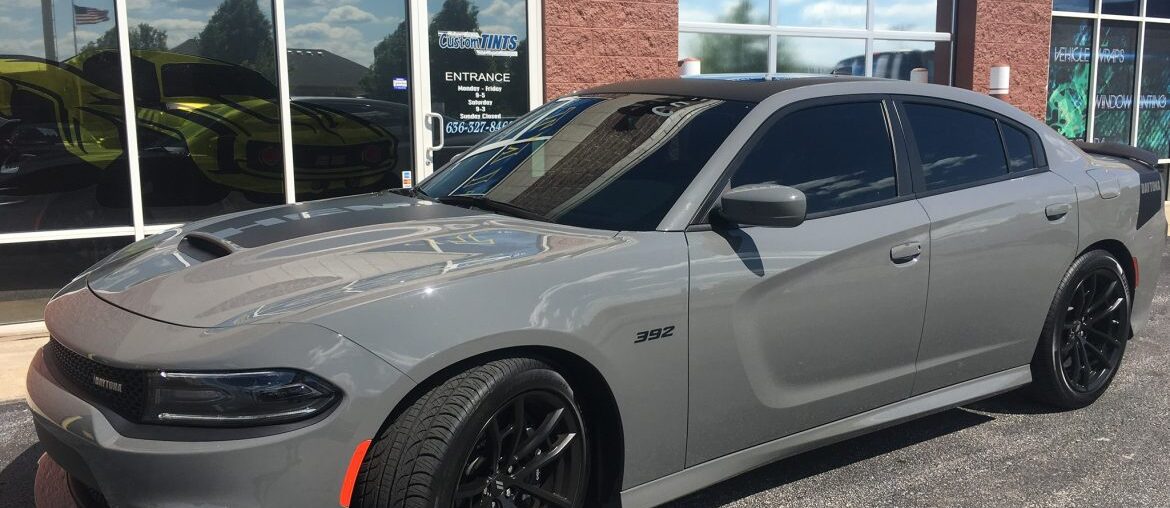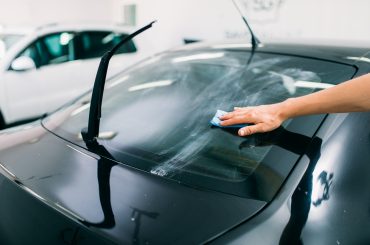The choice of regular vs ceramic window tint might be a challenging task if you are not familiar with the two types. There are various types of car window tints. Some are mainly designed for aesthetic appeal while others are designed mainly for the purpose of protection from harmful radiation such as UV and IR.
Regular car tints would be ideal for making your car look more stylish and fashionable. But, ceramic window tint would be the ideal product for complete protection. What are these two types? Let’s identify them.
Table of Contents
What is Regular Tint?
These are also known as the standard window tint. The regular tint is the most common type used for sun protection. It also helps in securing privacy, as they can be customized to have darker shades.
They consist of dark colors such as brown and gray in the spectrum of black with slight color variations. Due to their dark nature, they create a shady nature that blocks intense sunlight from entering. Nevertheless, the efficiency is not so high, as harmful UV radiations can still penetrate the window and increase the temperature inside.
A scratch-resistant coating is used to protect the film of tint from wearing off and tearing away. But this may not be highly effective as contact with sharp objects could make cuts on the film and gradually make it damaged with time. Hence, you should note that the regular tint is not so durable as the other types and needs to be re-tinted after some time. However, this is the most cost-efficient type, if you are looking for a car window tint for a low budget.
What is Ceramic Tint?
This too, consists of thin films of tint pasted over the glass windows. Tiny particles of ceramic are used as a coating on this thin film. These also consist of various shades to be chosen on the customer’s preference. Thus, it is a product of the new upcoming nano-ceramic technology.
The ceramic window tint is able to reflect back the sun rays that strike its surface. Hence, the inner temperature can be kept low, as the outside heat doesn’t get trapped inside. This is the best type of window tint in consideration of health aspects, as it blocks over 99% of unwanted harmful rays from penetrating.
There are many advantages of ceramic window tint over regular tint. Let’s identify these by investigating the differences between these two.
Differences between Ceramic Tint and Regular Tint
The following Table 1 shows the main differences between the ceramic tint and regular tint on car windows.
| Regular Tint | Ceramic Tint |
| Dyed and laminated films | Ceramic particle coated films |
| Can have many darker shades | Have lighter shades |
| Can have a range of color options | Lesser color options |
| Scratched or torn easily | Reduces sun glare |
| Subjected to wear and tear with time | Low subjection to wear and tear |
| Absorbs radiation | Reflects sunlight |
| Tint gets faded over time | Does not get faded over time |
| Might trap heat inside | No heat absorption |
| Less durable | Highly durable |
| UV rays can enter inside | Complete UV and IR ray rejection |
| Low structural stability of the film | High structural stability |
| High maintenance required | Less maintenance required |
| No complete protection | Maximum protection from harmful rays |
| Less expensive | More expensive |
To get more details about other varieties of window tints, refer to our article on Types of Window Tint. If you already have a regular window tint and you need to replace it with a better, advanced type of window tint, you would first need to remove the current window tint. For clarifications on this matter and further guidance, please refer to our article on How to Remove Window Tint.
Ceramic Window Tint VS Carbon Tint
If you are here indecisive about whether to use ceramic window tint or carbon tint, let us explain the differences and help you make the choice. The cost difference is very low and carbon tint would be slightly cheaper than ceramic tint. Both have very high standards in terms of protection from harmful radiation. Ceramic window tint is the latest and most technologically advanced type of all window tints.
Both carbon and ceramic have the same nanotechnology of heat rejection. But, carbon creates darker shades with more addition of particles. Even though more amount of ceramic is added to the tint, it does not increase the darkness of the film. More experimental researches are being conducted to minimize this visibility issue that occurs with the increase of carbon percentage on the tint films. But this has been the best option until the introduction of the latest technology of ceramic window tint.
When considering the properties of quality and durability, ceramic tint would get the highest score without doubt. Nevertheless, if you are running tight on budget, carbon tint might be the best option for you. The shatter-proof technology of ceramic is an added advantage that you might need in terms of security. But some people might not find interest in this feature. Both these window tint types have high immunity for solar heat gain. Both are less likely to get sun-faded over time. Hence, lasts long with the original conditions.
If your main concern would be high energy efficiency, carbon tint would be a great choice. Since ceramic tint is ahead of all the types of window tints at present, you might need to learn more about the benefits of ceramic window tint. So let’s talk about this.
Benefits of Ceramic Window Tint
Being the newest type of window tint available in the market, most people are interested in finding out the advancements and the benefits of this new type. The following are some of the most prominent benefits of ceramic window tint.
- UV Protection
Even though your windows may not be tinted, the glass would likely filter out certain harmful rays of UVA and UVB naturally. But still, a large number of harmful sun rays would penetrate through the glass. Continuous exposure to UV radiation would create negative effects on the skin and eyes. It would lead to skin conditions such as melanoma and would even result in skin cancer. Eyes could be damaged with diseases such as cataracts and macular degeneration which would cause blurry vision and loss of eyesight. Since ceramic tint provides you with proper UV protection, you can let a sigh of relief and avoid worrying about the risk to your health.
- Lesser Glare
If you are living in a tropical country or a sunny state that is bright throughout most parts of the day, you might know how annoying it is to drive in bright sunlight. Due to the high intensity in light for a long period of time, the eyes would get strained and tired, reducing the visibility. Thus, it is likely to cause more accidents on the road. The ceramic windows help reduce the glare by 50%. Thus, only half of the light would enter your car. So, you might feel more comfortable and less tired while driving. The ceramic film is optimized in such a way as to block and reduce the bright light while ensuring the visibility and safety of the people.
- No Signal Interference
The metalized tint is made up of fine metal parts and hence creates interruption with radio and GPS signals within the vehicle. So unlike in metalized tints, ceramic window tint does not create any interference with electronic signals inside the car. Therefore, you do not need to worry about dropping phone calls or losing radio signals while driving a car with ceramic tinted windows.
- Cooler Interior
In addition to blocking UV radiation, the ceramic tint is able to block over 80% of IR radiation which is responsible for the increase of heat inside the vehicle. Since the only low amount of IR radiation penetrates inside, the heat created inside would also be less, even if the car is out in the sun for long. Also, this would increase the life span and working conditions of the air conditioner as this reduces its workload. This would create less strain on the vehicle engine and ultimately add benefits to your economy.
- Privacy and Safety
Adding a tint on your car window creates a stylish look while increases privacy and safety as the onlookers cannot see the inside clearly. Since they cannot easily see the valuable things you have left behind inside the car, there is less chance of any breaking in or theft. It would also secure your privacy as you drive on the road or stop by a traffic jam, as outsiders are less likely to glare at you due to the lack of clear visibility from outside. After all, this is one of the most important benefits that anyone would look for, in a car window tint.
- Durable
The ceramic tint is made up of very minute nanoparticles that are tightly bound together. Hence, it adds more strength to the film, making it more durable and lasting longer. It would not get scratched easily and hence resistant to wear and tear, unlike the regular tint, which is more likely to get damaged. Hence, you would not need to replace the window tint so often like the regular ones which also adds a good score in terms of your wallet.
- High Quality
Due to the advanced nanotechnology of ceramic tint, the film adds more strength to the glass as well. Therefore, it is less likely to get damaged. Even though the glass is broken, the probability of getting shattered is very low. Therefore, this makes the windows safer even in the unfortunate event of an accident. This would also be a good guard for possible damages caused by the accidental hitting of stones, nuts, or balls.
Window Tint Temperature Difference
If you are wondering what might be the window tint temperature differences that might be created after you apply a new film of tint, then these facts are for you! Even though it might sound a bit confusing at first, there are perfectly acceptable scientific reasons as to how these temperatures reduce and by what degree the drop would occur.
The film of tint appears as a barrier between the sun and the inside of the car. The thermal energy is blocked either by absorbing or reflecting back, depending on the type of window tint. But, some amount of light energy is allowed to penetrate through this film, which brings some light inside and creates varying shades of darkness. With the increase of density of the fine particles on the tint, the shade would be darker and would also reject more heat.
The efficiency of a certain tint can be easily determined by the Visible Light Transmittance and Visible Light Absorption ratings. These are commonly referred to as VLT% and VLA%. For your further information, you can refer to our article on How to Calculate the VLT.
Even though the above ratings would describe the amount of light blocked, they do not clearly indicate the exact amount of cooling to be expected. According to various researches and experiments that have been done on this matter, it was identified that the interior air could be cooled down by about two degrees Celsius simply with an average sunshade on the vehicle.
Using tinted windows, the internal air was able to be cooled down by about eight degrees Celsius. It was because the ambient temperature could be reduced in both the front end and the rear end of the vehicle.
This experiment has been performed by using a relatively weak tint that could only block IR around 75%. So when considering the advanced types of tint in the market today, this would be even more effective. The temperature inside the car would be reduced in a large amount through the optimum solutions such as carbon tint and ceramic tint films.
Why You Should Care About Reducing Interior Heat
Windows occupy a large area of the vehicle’s surface. Both light and heat penetrate into the interior of the vehicle through this. In practice, if subjected to excessive heat, the internal temperature of the vehicle could easily rise by about 19 degrees Celsius within a small time period of about 15 minutes. You can simply imagine the consequences that could occur if this heat exposure continues for few more hours.
If you enter an excessively heated vehicle, it would directly affect your health. The body temperature would rise beyond 104 degrees and cause dehydration and heat strokes. When the interior plastics get heated up, it would create toxic, carcinogenic gases inside the car and might end up in deadly repercussions.
Also, the interior of your car would get heavily damaged due to the continuity of intense heat trapped inside the vehicle. It would result in the untimely wearing off of vehicle parts and the need to replace them more frequently. Even though these vehicle parts can be replaced even at a high cost, human organs and lives cannot be replaced at any cost. So, make the easy choice of reducing the interior heat of your vehicle. Use a proper window tint that would suit your budget, and also safeguard you properly.
Is Ceramic Window Tint Worth it?
At the end of all the research and references, this would be the terminal cost that any person would come up with. Every person expects to get the best out of the money they invest. So honestly, is ceramic window tint worth it for real? Let’s investigate this matter.
In a nutshell, the ceramic tint film offers IR protection, UV shield, lowest signal interference, high stability, improved strength, very low maintenance, and impressive durability. Therefore, it is evident that investing in ceramic window tint would not let you down at any cost. So, if you have a good budget, it is highly recommended to go for it. Give your car a stylish look and get yourself good protection by investing in a brand new film of ceramic window tint.
Is Ceramic Tint Legal?
Depending on certain rules and regulations that you might have come across in the knowledge of window tints, you might be wondering whether ceramic tint is legal and whether you can travel wherever with it.
This doubt can be clarified easily if you refer to our previous article that contains details on ‘What are the different tint percentages?’ it would provide a good explanation on various types of darkness percentages along with their effects on visibility. Hence, the visibility factor determines whether the shade of darkness is allowed or restricted within the country. For an instance, some countries and states do not allow any additional window tint on the front windows of the vehicle. this may be due to various security reasons applicable for the country.
This would vary depending on the state or country you live in. Even though ceramic tint is not declared illegal by name, there may be various restrictions applicable in the long run. So, it is advised to follow the laws at all times.
image source: Internet








